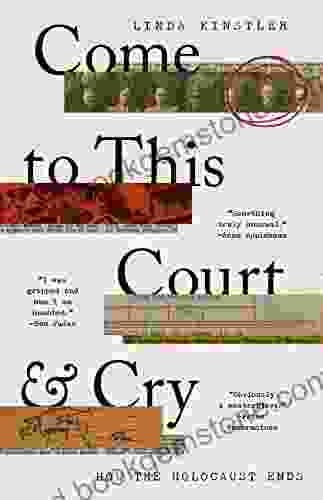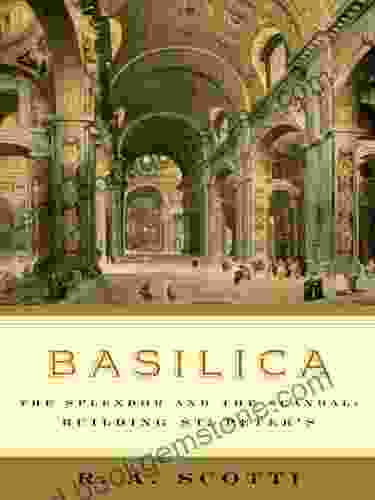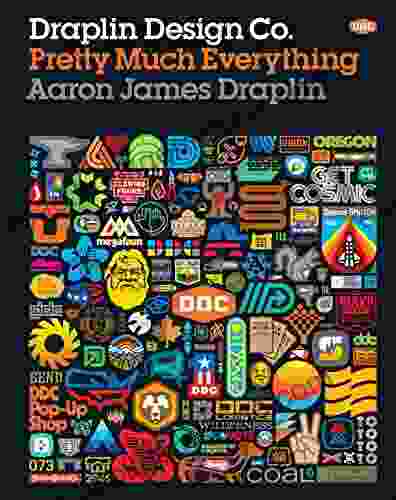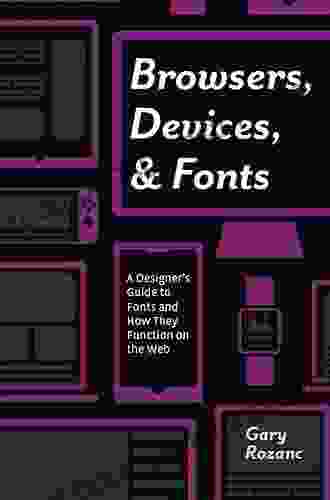Browsers, Devices, and Fonts: A Comprehensive Guide for Web Designers

In today's digital world, it is more important than ever for web designers to understand the different browsers, devices, and fonts that their users will be using. By understanding the capabilities and limitations of each platform, designers can create websites that are accessible and enjoyable for everyone.
This guide will provide a comprehensive overview of browsers, devices, and fonts, including the latest trends and best practices. We will also discuss some of the challenges that designers face when creating websites that are compatible with multiple platforms.
A web browser is a software application that allows users to access and view websites. There are many different browsers available, each with its own unique features and capabilities. Some of the most popular browsers include:
5 out of 5
| Language | : | English |
| File size | : | 20063 KB |
| Text-to-Speech | : | Enabled |
| Screen Reader | : | Supported |
| Enhanced typesetting | : | Enabled |
| Print length | : | 201 pages |
- Google Chrome
- Mozilla Firefox
- Safari
- Microsoft Edge
- Opera
When designing a website, it is important to consider the different browsers that your users will be using. Different browsers may render your website differently, so it is important to test your website in multiple browsers to ensure that it looks and functions properly.
When considering the different browsers that your users will be using, it is important to be aware of the different features that each browser supports. Some of the most common browser features include:
- HTML5: HTML5 is the latest version of the Hypertext Markup Language (HTML),the code that is used to create websites. HTML5 supports a wide range of new features, including video, audio, and canvas elements.
- CSS3: CSS3 is the latest version of Cascading Style Sheets (CSS),the language that is used to style websites. CSS3 supports a wide range of new features, including rounded corners, drop shadows, and gradients.
- JavaScript: JavaScript is a programming language that can be used to add interactivity to websites. JavaScript can be used to create things like menus, forms, and games.
- Cookies: Cookies are small text files that are stored on a user's computer. Cookies can be used to track a user's activity on a website, such as the pages they visit and the products they add to their shopping cart.
- Plugins: Plugins are add-ons that can be installed in a browser to add new features. Plugins can be used to add things like support for new video formats, social media integration, and anti-virus protection.
When designing a website, it is also important to be aware of the market share of different browsers. Market share refers to the percentage of users who use a particular browser. The following table shows the market share of the top five browsers as of January 2023:
| Browser | Market Share | |---|---| | Google Chrome | 65.3% | | Mozilla Firefox | 10.1% | | Safari | 9.6% | | Microsoft Edge | 4.5% | | Opera | 2.4% |
As you can see, Google Chrome is the most popular browser by far. This means that it is important to test your website in Google Chrome to ensure that it looks and functions properly. However, it is also important to test your website in other browsers to ensure that it is compatible with as many platforms as possible.
In addition to browsers, it is also important to consider the different devices that your users will be using to access your website. These days, people use a wide range of devices to access the internet, including:
- Desktop computers
- Laptops
- Tablets
- Smartphones
- Smart TVs
Each type of device has its own unique set of capabilities and limitations. For example, desktop computers have large screens and powerful processors, while smartphones have small screens and limited processing power. When designing a website, it is important to consider the different devices that your users will be using and to make sure that your website looks and functions properly on all of them.
When considering the different devices that your users will be using, it is important to be aware of the different features that each device supports. Some of the most common device features include:
- Screen size: The screen size of a device is measured in pixels. The higher the screen resolution, the more pixels the device can display.
- Processor speed: The processor speed of a device is measured in gigahertz (GHz). The higher the processor speed, the faster the device can process information.
- Memory: The memory of a device is measured in gigabytes (GB). The more memory a device has, the more apps and data it can store.
- Storage space: The storage space of a device is measured in gigabytes (GB). The more storage space a device has, the more files and apps it can store.
- Battery life: The battery life of a device is measured in hours. The longer the battery life, the longer the device can be used without needing to be recharged.
When designing a website, it is also important to be aware of the market share of different devices. Market share refers to the percentage of users who use a particular device. The following table shows the market
5 out of 5
| Language | : | English |
| File size | : | 20063 KB |
| Text-to-Speech | : | Enabled |
| Screen Reader | : | Supported |
| Enhanced typesetting | : | Enabled |
| Print length | : | 201 pages |
Do you want to contribute by writing guest posts on this blog?
Please contact us and send us a resume of previous articles that you have written.
 Best Book
Best Book Page Flip
Page Flip Bookshelf
Bookshelf Literary loom
Literary loom Chapter
Chapter Bookish
Bookish PageTurner
PageTurner Bibliophile
Bibliophile Story
Story Inkwell
Inkwell Bookworm
Bookworm Labyrinth
Labyrinth Plot Twist
Plot Twist Prose
Prose Paperback
Paperback Storyteller
Storyteller Sanctuary
Sanctuary Fiction
Fiction Reading
Reading Chronicle
Chronicle Read
Read Christopher Ruocchio
Christopher Ruocchio Sarah Noffke
Sarah Noffke Michael A Almond
Michael A Almond Michelle Knight
Michelle Knight Aaron James Draplin
Aaron James Draplin Tom Cotter
Tom Cotter Bruce Scivally
Bruce Scivally Brandon Sanderson
Brandon Sanderson Lewis Hyde
Lewis Hyde Charles Barr
Charles Barr Jack Hunt
Jack Hunt Stan Zimmerman
Stan Zimmerman Jenny Mcgill
Jenny Mcgill C C Alma
C C Alma Joshua Samuel Brown
Joshua Samuel Brown Barbara Newton
Barbara Newton Martin Fletcher
Martin Fletcher Marina Berkovich
Marina Berkovich Theophilus Monroe
Theophilus Monroe Rebecca Vincent
Rebecca Vincent Erwin Rosenthal
Erwin Rosenthal Suyi Davies Okungbowa
Suyi Davies Okungbowa Catie Marron
Catie Marron Yvonne Wakefield
Yvonne Wakefield Negar Mottahedeh
Negar Mottahedeh M P Woodward
M P Woodward J C Cannell
J C Cannell Yihui Xie
Yihui Xie Shannon Pemrick
Shannon Pemrick Adam Bray
Adam Bray Collins Uk
Collins Uk Victoria Buitron
Victoria Buitron Catherine Kapphahn
Catherine Kapphahn Alastair Campbell
Alastair Campbell Porsha Williams
Porsha Williams Susie Kalil
Susie Kalil Jay Boyce
Jay Boyce Jan Gaye
Jan Gaye 3dtotal Publishing
3dtotal Publishing Joanna Merlin
Joanna Merlin John Gimlette
John Gimlette Jit Baral
Jit Baral Charissa N Terranova
Charissa N Terranova James Willard Schultz
James Willard Schultz Ann Fensterstock
Ann Fensterstock Rebecca Dwight Bruff
Rebecca Dwight Bruff Philippe Chantepie
Philippe Chantepie Richard Kaufman
Richard Kaufman Pierre Alex Jeanty
Pierre Alex Jeanty Bryony Gomez Palacio
Bryony Gomez Palacio Charles Bowden
Charles Bowden Isabella Decarlo
Isabella Decarlo Robert S Birchard
Robert S Birchard Richard Taylor
Richard Taylor Graham Fraser
Graham Fraser William O Connor
William O Connor Rocky Nielsen
Rocky Nielsen Benedict Jacka
Benedict Jacka Christopher James
Christopher James Madeleine Korbel Albright
Madeleine Korbel Albright Aaron Dembski Bowden
Aaron Dembski Bowden Paul C Middleton
Paul C Middleton Kate Clifford Larson
Kate Clifford Larson Gary Earl Ross
Gary Earl Ross Bruce Carroll
Bruce Carroll Rachel Woods
Rachel Woods Deby Coles
Deby Coles Julian Barnes
Julian Barnes Rich Horton
Rich Horton 1st Edition Kindle Edition
1st Edition Kindle Edition Sarah Fraser
Sarah Fraser Weijian Shan
Weijian Shan Jack Womack
Jack Womack Helen Raleigh
Helen Raleigh Andrew Forkner
Andrew Forkner Alta Macadam
Alta Macadam Bernie Schein
Bernie Schein Megan Mackie
Megan Mackie David Cousens
David Cousens A J Finn
A J Finn Neil A Hogan
Neil A Hogan A Michael Shumate
A Michael Shumate Gary Phillips
Gary Phillips Marina Abramovic
Marina Abramovic Bob Chapman
Bob Chapman Christopher L Cirillo
Christopher L Cirillo Michael Crichton
Michael Crichton A S Byatt
A S Byatt A American
A American Linea Johnson
Linea Johnson Guidora Team
Guidora Team Ranim Nourallah
Ranim Nourallah Trevor Boffone
Trevor Boffone Renato Perdon
Renato Perdon Jeffrey Wilson
Jeffrey Wilson Lina Chang
Lina Chang Paul Austin Ardoin
Paul Austin Ardoin Audre Lorde
Audre Lorde Trice Hickman
Trice Hickman Lisa Maker
Lisa Maker Lisa Jackson
Lisa Jackson Catherine Belsey
Catherine Belsey Julie Metz
Julie Metz Aaris Sherin
Aaris Sherin Carl Little
Carl Little Cynthia Knox
Cynthia Knox Ben Ryan
Ben Ryan Agathe Singer
Agathe Singer Robin Barratt
Robin Barratt Ruth Millington
Ruth Millington Leesa Cross Smith
Leesa Cross Smith Diana K Schwam
Diana K Schwam Brian Morton
Brian Morton David Nabhan
David Nabhan Giorgia Lupi
Giorgia Lupi Leonard Peltier
Leonard Peltier A A Villescas
A A Villescas Judy O Haselhoef
Judy O Haselhoef R Allen Hardy
R Allen Hardy Justin Catanoso
Justin Catanoso Tony Spawforth
Tony Spawforth Lakia
Lakia David Batchelor
David Batchelor Peter Swanson
Peter Swanson Etienne De Backer
Etienne De Backer Jarrett Wrisley
Jarrett Wrisley Harry Turtledove
Harry Turtledove Samantha Seiple
Samantha Seiple Carlos Simpson
Carlos Simpson Roger Williams
Roger Williams Chris Bond
Chris Bond Partha Mitter
Partha Mitter Nanna Katrine Luders Kaalund
Nanna Katrine Luders Kaalund Susan R Barry
Susan R Barry Dmitry Samarov
Dmitry Samarov Bwwm Club
Bwwm Club Mark Greaney
Mark Greaney Daniel Sheets Dye
Daniel Sheets Dye Alex Kosh
Alex Kosh Paul Hill
Paul Hill Elena Ferro
Elena Ferro Bernardine Evaristo
Bernardine Evaristo Marjorie Lambert
Marjorie Lambert Karin Tanabe
Karin Tanabe Alyssa Cole
Alyssa Cole Pete Buckley
Pete Buckley Delia Gray Durant
Delia Gray Durant Brittany Gibbons
Brittany Gibbons Nick Athanas
Nick Athanas Walter Crane
Walter Crane Mark Jones
Mark Jones Danny Garcia
Danny Garcia Nick Iuppa
Nick Iuppa Natasha Sims
Natasha Sims Doug Risner
Doug Risner Tracey Cohen
Tracey Cohen Paul Norbury
Paul Norbury Thomas Lockwood
Thomas Lockwood Andrew Crone
Andrew Crone Alberta Arthurs
Alberta Arthurs Dwight Roth
Dwight Roth John E Siers
John E Siers John D Gartner
John D Gartner Leo Kahl
Leo Kahl Henry White
Henry White Alex Stone
Alex Stone Kaylie Kay
Kaylie Kay Gerald Shea
Gerald Shea Ann Fisher
Ann Fisher Donna Digiuseppe
Donna Digiuseppe Mamie Till Mobley
Mamie Till Mobley John F Callahan
John F Callahan David Newton
David Newton Kamo
Kamo Fernanda Melchor
Fernanda Melchor Jenell Diegor
Jenell Diegor Juliet Rieden
Juliet Rieden Mark J Rose
Mark J Rose Shana Vanterpool
Shana Vanterpool Amarilys Henderson
Amarilys Henderson Laurence Matthews
Laurence Matthews Anuj Tikku
Anuj Tikku Catherine Grace Katz
Catherine Grace Katz Mary Kubica
Mary Kubica Jen Santos
Jen Santos Sharon Shinn
Sharon Shinn Brant Antonson
Brant Antonson Henri Piquer
Henri Piquer Stephen Haddelsey
Stephen Haddelsey Zen Cho
Zen Cho Joseph D Addetta
Joseph D Addetta Kresley Cole
Kresley Cole Tony Corden
Tony Corden John Hopkins
John Hopkins A K Duboff
A K Duboff Jung Yun
Jung Yun Gary David Bouton
Gary David Bouton Donald Bogle
Donald Bogle A C Arthur
A C Arthur John Edson
John Edson Janice Dean Willis
Janice Dean Willis Andre Iguodala
Andre Iguodala Roman Plesky
Roman Plesky Joseph M Mascia
Joseph M Mascia Carma Gorman
Carma Gorman Carrie Prudence Winter
Carrie Prudence Winter Mo Yan
Mo Yan Bill Gardner
Bill Gardner Paraluman S Aspillera
Paraluman S Aspillera Aaron Fine
Aaron Fine Fred Crellin
Fred Crellin Marina Jarre
Marina Jarre Eduardo F Calcines
Eduardo F Calcines Larry Moss
Larry Moss A Desaint
A Desaint Joseph Farrell
Joseph Farrell Jihyun Park
Jihyun Park Rhys Bowen
Rhys Bowen Robyn Wideman
Robyn Wideman Susan Veness
Susan Veness Laura Lee Fritz
Laura Lee Fritz Shvonne Latrice
Shvonne Latrice Aaron Bobrow Strain
Aaron Bobrow Strain Sara Novic
Sara Novic Insight Traveller
Insight Traveller Aimee Song
Aimee Song Matthew Poehler
Matthew Poehler Jon Tucker
Jon Tucker Beth Reiber
Beth Reiber Dave Willmarth
Dave Willmarth Actus
Actus Gregory Mirow
Gregory Mirow Christopher Ingraham
Christopher Ingraham Kathy Arlyn Sokol
Kathy Arlyn Sokol Clive Cussler
Clive Cussler S M Warlow
S M Warlow Douglas Dorow
Douglas Dorow Maureen Egan
Maureen Egan Christa Upton
Christa Upton Mark Harris
Mark Harris R H Sin
R H Sin Clint Salter
Clint Salter Leslie Cabarga
Leslie Cabarga Patricia Bjaaland Welch
Patricia Bjaaland Welch Derek Hough
Derek Hough Michael C Grumley
Michael C Grumley Bob Sehlinger
Bob Sehlinger Mosy Brigth
Mosy Brigth Elizabeth Strout
Elizabeth Strout Melverna Mcfarlane
Melverna Mcfarlane Douglas E Richards
Douglas E Richards Peter Rush
Peter Rush Thom Wall
Thom Wall Jennifer Rosner
Jennifer Rosner Ramze Suliman
Ramze Suliman R W W Greene
R W W Greene Deborah Hay
Deborah Hay Jeaniene Frost
Jeaniene Frost Alexander William Kinglake
Alexander William Kinglake Juno Wells
Juno Wells Jennifer Bohnet
Jennifer Bohnet John Christian Hopkins
John Christian Hopkins Yanis Varoufakis
Yanis Varoufakis Natasha Lawyer
Natasha Lawyer Mari Sandoz
Mari Sandoz Fred Arroyo
Fred Arroyo John Marmysz
John Marmysz Glennon Doyle
Glennon Doyle Robert E Kapsis
Robert E Kapsis Joseph Q Jarvis
Joseph Q Jarvis S L Partee
S L Partee Jeff A Menges
Jeff A Menges Rowland B Wilson
Rowland B Wilson Joshua Bloom
Joshua Bloom Dean Wesley Smith
Dean Wesley Smith Paul Daugherty
Paul Daugherty Elizabeth Kendall
Elizabeth Kendall Olympia Black
Olympia Black Dustin Stevens
Dustin Stevens Michael Brooke
Michael Brooke Victor Margolin
Victor Margolin Christopher Fowler
Christopher Fowler Darren Royston
Darren Royston Trevor Norton
Trevor Norton Cecelia Dowdy
Cecelia Dowdy Ethan De Seife
Ethan De Seife Dean C Moore
Dean C Moore Brad Thor
Brad Thor Arnold Lowrey
Arnold Lowrey Robert Fleming
Robert Fleming Cora Harrington
Cora Harrington Jessica Augustsson
Jessica Augustsson Victor Godinez
Victor Godinez Aileen Bordman
Aileen Bordman Charles Foran
Charles Foran Merick N H Ulrik
Merick N H Ulrik Sylvia D Lynch
Sylvia D Lynch Luis Tiant
Luis Tiant J B Bobo
J B Bobo Dani Cavallaro
Dani Cavallaro Donald Richie
Donald Richie Mary Jane Houlton
Mary Jane Houlton Burt Wrenlaw
Burt Wrenlaw Brandi Carlile
Brandi Carlile Noah Scalin
Noah Scalin Michael Wigge
Michael Wigge Belle Yang
Belle Yang Erin Khar
Erin Khar Mary Gabriel
Mary Gabriel Peter Cozzens
Peter Cozzens Tom Sullivan
Tom Sullivan Winki
Winki Scotia Gilroy
Scotia Gilroy Marlon James
Marlon James Gustavo Arellano
Gustavo Arellano Kate Langbroek
Kate Langbroek Beate Sirota Gordon
Beate Sirota Gordon Laura L Engel
Laura L Engel Tenzin Priyadarshi
Tenzin Priyadarshi Dawn Loring
Dawn Loring Darra Goldstein
Darra Goldstein Sarah Bird
Sarah Bird Roberta Milliken
Roberta Milliken Seth Ring
Seth Ring Victor Steffensen
Victor Steffensen Terence Biffi
Terence Biffi A Sanguineti
A Sanguineti David Garner
David Garner Marie Arana
Marie Arana Bill Neeley
Bill Neeley Valeria Luiselli
Valeria Luiselli Martha Wainwright
Martha Wainwright Megan Goldmine
Megan Goldmine Linda Kinstler
Linda Kinstler A D Davies
A D Davies Maryanne Peters
Maryanne Peters Simon Scarrow
Simon Scarrow T Ann Marie
T Ann Marie Stanley Green
Stanley Green Jeffrey Eugenides
Jeffrey Eugenides Penelope Douglas
Penelope Douglas Anne Wheeler
Anne Wheeler Shirlene Obuobi
Shirlene Obuobi James Egan
James Egan Elsebeth Lavold
Elsebeth Lavold David Hinton
David Hinton Troy Denning
Troy Denning Richard F Fleck
Richard F Fleck Scott Peters
Scott Peters Gary Orleck
Gary Orleck Meyer Levin
Meyer Levin Ralph Ellison
Ralph Ellison Mark Dery
Mark Dery Tao Wong
Tao Wong Jane Alexander
Jane Alexander E Train Learning
E Train Learning Edmund De Waal
Edmund De Waal Harmony Bench
Harmony Bench John Cheever
John Cheever Emily Gosling
Emily Gosling Chris Hechtl
Chris Hechtl Kelly Mills
Kelly Mills Paul R Wonning
Paul R Wonning Sarah Torrecillas
Sarah Torrecillas Aaron Barron
Aaron Barron Brian J Robb
Brian J Robb S E Smith
S E Smith Chris Backe
Chris Backe Chris Robinson
Chris Robinson David Hornung
David Hornung Nawar Shora
Nawar Shora Daniel Tudor
Daniel Tudor Walter Jon Williams
Walter Jon Williams Rose Gonnella
Rose Gonnella Stephen Powell
Stephen Powell Sam Hampton Smith
Sam Hampton Smith Julia Whelan
Julia Whelan Jennifer Natalya Fink
Jennifer Natalya Fink Shira Lipkin
Shira Lipkin Donald B Mcfarlane
Donald B Mcfarlane Carol Boyle
Carol Boyle Garry Apgar
Garry Apgar Nikki Giovanni
Nikki Giovanni Goddess Love
Goddess Love W David Baird
W David Baird Daniel Jacobs
Daniel Jacobs Rosemary Edghill
Rosemary Edghill Joe Upton
Joe Upton Stephanie Thornton
Stephanie Thornton Colin Post
Colin Post Michael F Keaney
Michael F Keaney Tori Harris
Tori Harris Julia Elizabeth Sloan
Julia Elizabeth Sloan J T Brannan
J T Brannan Heather Young
Heather Young Elizabeth Currie
Elizabeth Currie Sabra Waldfogel
Sabra Waldfogel Scott Lunt
Scott Lunt Jeff Howard
Jeff Howard Bruce Sentar
Bruce Sentar Greydon Clark
Greydon Clark 1st Ed 2019 Edition Kindle Edition
1st Ed 2019 Edition Kindle Edition Tony Barr
Tony Barr Michael Petrou
Michael Petrou A M Sohma
A M Sohma Laurie Gwen Shapiro
Laurie Gwen Shapiro Ron Mcninch
Ron Mcninch Daniel Mathews
Daniel Mathews A P Bateman
A P Bateman J D Sullivan
J D Sullivan C Napier Bell
C Napier Bell Richard Wagamese
Richard Wagamese Dale Brown
Dale Brown William Bennet Stevenson
William Bennet Stevenson Debra Meyerson
Debra Meyerson David Lewis
David Lewis R A Scotti
R A Scotti Jill Santopolo
Jill Santopolo Greg Sarris
Greg Sarris Tina Martin
Tina Martin Lindsay Buroker
Lindsay Buroker Laura J Mixon
Laura J Mixon Dave Austin
Dave Austin Nek Hickmon
Nek Hickmon Ann Patchett
Ann Patchett Lynn Michelsohn
Lynn Michelsohn Ayano Otani
Ayano Otani Ken Liu
Ken Liu Steve Gladstone
Steve Gladstone Dale Sherman
Dale Sherman Ann V Winterbotham
Ann V Winterbotham Jeffrey Alford
Jeffrey Alford Andy Clark
Andy Clark A R Corbin
A R Corbin Shelly Culbertson
Shelly Culbertson Vicky Unwin
Vicky Unwin A J Alonzo Wind
A J Alonzo Wind David Sipress
David Sipress Michael Roberts
Michael Roberts Peter A Koenig
Peter A Koenig Peter Watts
Peter Watts Gary O Neal
Gary O Neal David Feintuch
David Feintuch Salvador Dali
Salvador Dali Paolo Hewitt
Paolo Hewitt Soraya French
Soraya French David Bergsland
David Bergsland Shannon Leone Fowler
Shannon Leone Fowler Leatrice Eiseman
Leatrice Eiseman Reed Tucker
Reed Tucker Tania Romanov
Tania Romanov Jeremy Hicks
Jeremy Hicks Ina Knobloch
Ina Knobloch Christine Skwiot
Christine Skwiot Gary Heath
Gary Heath Andy Fletcher
Andy Fletcher Jesse Day
Jesse Day Charles Johnson
Charles Johnson Reginald Fleming Johnston
Reginald Fleming Johnston Brette Sember
Brette Sember James M Mcpherson
James M Mcpherson Editors Of Creative Publishing International
Editors Of Creative Publishing International Tyrel Nelson
Tyrel Nelson Henry Dreyfuss
Henry Dreyfuss Danielle Ofri
Danielle Ofri Aisling Juanjuan Shen
Aisling Juanjuan Shen Karen Speerstra
Karen Speerstra Shantiana Cooper
Shantiana Cooper Terrance Mulloy
Terrance Mulloy William Middleton
William Middleton Stephen Farthing
Stephen Farthing Bill Robinson
Bill Robinson Soon Y Warren
Soon Y Warren Octavia E Butler
Octavia E Butler Ernest Chesneau
Ernest Chesneau K Reynolds James
K Reynolds James Selena Montgomery
Selena Montgomery Calvin Tomkins
Calvin Tomkins Eddie Lennon
Eddie Lennon Alison Bechdel
Alison Bechdel Jane Allen Petrick
Jane Allen Petrick Janice Cavell
Janice Cavell James Abell
James Abell Tonya Burrows
Tonya Burrows Cynthia Sax
Cynthia Sax Bridget Quinn
Bridget Quinn Melissa Fu
Melissa Fu Brad Warner
Brad Warner Nigel Cross
Nigel Cross Birnbaum Guides
Birnbaum Guides Ray Balkwill
Ray Balkwill Todd Mcgowan
Todd Mcgowan Dannion Brinkley
Dannion Brinkley Thais Riotto
Thais Riotto Karen Haid
Karen Haid Richard Condit
Richard Condit Jo Charnock
Jo Charnock A C Crispin
A C Crispin Kathleen Jones
Kathleen Jones Aabis Johnson
Aabis Johnson Zoe Ingram
Zoe Ingram James Just
James Just Toby Neighbors
Toby Neighbors Jonathan Harr
Jonathan Harr Cyrus Massoudi
Cyrus Massoudi Jhumpa Lahiri
Jhumpa Lahiri Kitiara Pascoe
Kitiara Pascoe Tara Bray Smith
Tara Bray Smith Kira Salak
Kira Salak Neil Hutchison
Neil Hutchison Natasha Brown
Natasha Brown Koichi Hagawa
Koichi Hagawa James Osiris Baldwin
James Osiris Baldwin Jeffrey Ford
Jeffrey Ford Daniel Van
Daniel Van Maxim D Shrayer
Maxim D Shrayer Phyllis Birnbaum
Phyllis Birnbaum Heinrich Klutschak
Heinrich Klutschak Tim Lebbon
Tim Lebbon Cazzie David
Cazzie David Joel Paul Reisig
Joel Paul Reisig Morgan Jerkins
Morgan Jerkins Tommaso Astarita
Tommaso Astarita Shawna Sharee
Shawna Sharee Heather Webb
Heather Webb Dean Simmons
Dean Simmons Rosalind Rosenberg
Rosalind Rosenberg Javier Zamora
Javier Zamora Sean Michael Andrews
Sean Michael Andrews David Parker
David Parker Don Croner
Don Croner Sambou Kamissoko
Sambou Kamissoko Diana Marcum
Diana Marcum David Elliot Cohen
David Elliot Cohen Kate Clair
Kate Clair Dean Dalton
Dean Dalton Sylvester Murray
Sylvester Murray Dk
Dk Jane M Newby
Jane M Newby Hilary Hughes Loftus
Hilary Hughes Loftus Shemer Kuznits
Shemer Kuznits Gautam Raghavan
Gautam Raghavan Gail Lukasik
Gail Lukasik Casey Gerald
Casey Gerald Margo Porras
Margo Porras Jules Gailhabaud
Jules Gailhabaud Sean Willson
Sean Willson Bob Kaufman
Bob Kaufman Phylis Johnson
Phylis Johnson Margo Bond Collins
Margo Bond Collins Sam Tranum
Sam Tranum Ernest R Norling
Ernest R Norling Sheila Weller
Sheila Weller Tarana Burke
Tarana Burke Ray Loriga
Ray Loriga Andres Lopez
Andres Lopez Joanna Kulesza
Joanna Kulesza Noah Brooks
Noah Brooks Nick Jones
Nick Jones Michelle Vogel
Michelle Vogel Gay Talese
Gay Talese Charles Alexander Eastman
Charles Alexander Eastman Joan Wiener Bordow
Joan Wiener Bordow A R Burns
A R Burns Steve Kaffen
Steve Kaffen Edward Leo
Edward Leo Ava Ross
Ava Ross David Blacklock
David Blacklock A F Kay
A F Kay Blake Gopnik
Blake Gopnik Maggie Black
Maggie Black Belinda Jones
Belinda Jones David Gentleman
David Gentleman Roxie Mcclaine
Roxie Mcclaine Laura Shumaker
Laura Shumaker C J Cherryh
C J Cherryh Nathan Brown
Nathan Brown William F Powell
William F Powell Maisy Card
Maisy Card Robert Shufflebotham
Robert Shufflebotham Michael Gross
Michael Gross Kate Sekules
Kate Sekules Ted Riese
Ted Riese Tricia Martineau Wagner
Tricia Martineau Wagner Maud Fontenoy
Maud Fontenoy Charles Harrison
Charles Harrison Cixin Liu
Cixin Liu Alison C Board
Alison C Board Alex W White
Alex W White Stephen Baxter
Stephen Baxter Amanda Conner
Amanda Conner V S Naipaul
V S Naipaul Mary Jane Walker
Mary Jane Walker Luther Standing Bear
Luther Standing Bear Shellise Berry
Shellise Berry Brandon Ellis
Brandon Ellis Mary Prince
Mary Prince M N Forgy
M N Forgy K Kris Loomis
K Kris Loomis Sam J Miller
Sam J Miller Diego Enrique Osorno
Diego Enrique Osorno Michael Bierut
Michael Bierut Lisa Rose Wright
Lisa Rose Wright J M Phillips
J M Phillips Mel Laytner
Mel Laytner James Robert
James Robert Alexandre Roger
Alexandre Roger Koloman Moser
Koloman Moser Maria Sibylla Merian
Maria Sibylla Merian Stephen Chambers
Stephen Chambers Gregory Crouch
Gregory Crouch Mazie K Hirono
Mazie K Hirono Kenneth Clark
Kenneth Clark Monica Peach
Monica Peach Anne Strathie
Anne Strathie Lawrence F Lihosit
Lawrence F Lihosit Raymond Goodburn
Raymond Goodburn Jennifer Melville
Jennifer Melville Annalyn Swan
Annalyn Swan Shaa Fazal
Shaa Fazal Daniel Gordis
Daniel Gordis 1st Ed 2018 Edition Kindle Edition
1st Ed 2018 Edition Kindle Edition 2nd Edition Kindle Edition
2nd Edition Kindle Edition Nicole Koetter
Nicole Koetter Barbara Barrett
Barbara Barrett Lisa Ohlen Harris
Lisa Ohlen Harris Larry Niven
Larry Niven Dami Lee
Dami Lee
Light bulbAdvertise smarter! Our strategic ad space ensures maximum exposure. Reserve your spot today!
 Dylan MitchellFollow ·12.1k
Dylan MitchellFollow ·12.1k John GrishamFollow ·10.9k
John GrishamFollow ·10.9k Harry CookFollow ·3k
Harry CookFollow ·3k Alex FosterFollow ·5k
Alex FosterFollow ·5k Brody PowellFollow ·14.9k
Brody PowellFollow ·14.9k Jack ButlerFollow ·5.1k
Jack ButlerFollow ·5.1k Douglas PowellFollow ·4.4k
Douglas PowellFollow ·4.4k Enrique BlairFollow ·14.9k
Enrique BlairFollow ·14.9k

 Lucas Reed
Lucas ReedFantasy Technology and Politics: A Deep Dive into the...
Fantasy literature...

 Blake Kennedy
Blake KennedyCome To This Court And Cry: A Tale of Love, Loss, and...
Come To This Court And Cry...

 Kendall Ward
Kendall WardThe Majestic Edifice: Exploring the History and...
St. Peter's Basilica, an architectural...

 Emmett Mitchell
Emmett MitchellDraplin Design Co.: Pretty Much Everything
Who is Draplin Design Co.? Draplin Design...

 Eliot Foster
Eliot FosterUnveiling the Enthralling Literary Cosmos of Against Time...
Prologue: A Quantum Nexus of Time and...

 Connor Mitchell
Connor MitchellMy Journey Through the Labyrinth of Low-Budget...
In the enthralling realm of filmmaking,...
5 out of 5
| Language | : | English |
| File size | : | 20063 KB |
| Text-to-Speech | : | Enabled |
| Screen Reader | : | Supported |
| Enhanced typesetting | : | Enabled |
| Print length | : | 201 pages |












